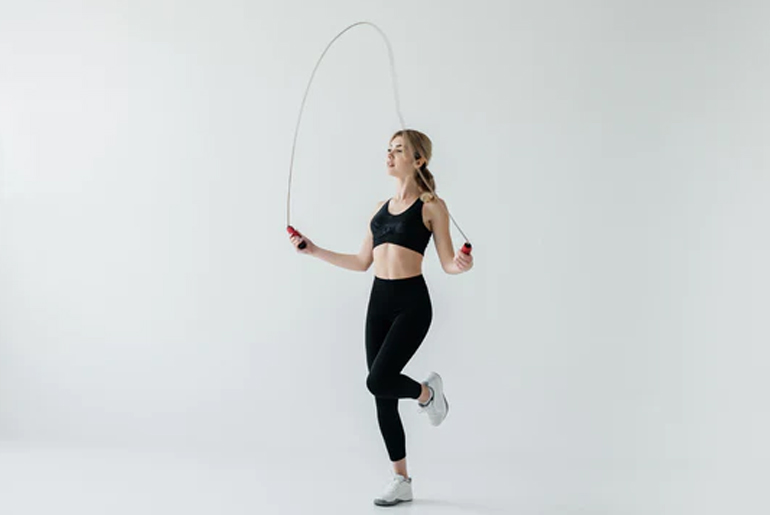Jumping rope is a versatile and enjoyable form of aerobic exercise suitable for individuals of all ages. It goes beyond childhood nostalgia, offering accessibility, flexibility, and a range of health benefits. An orthopedic surgeon and sports medicine specialist, emphasizes that jump rope workouts are simple, cost-effective exercises that can be learned by almost anyone, requiring minimal equipment and allowing for practice virtually anywhere.
A Jump Rope Workout:
A jump rope workout is a versatile exercise routine that can range from a simple session of skipping to a more advanced, high-intensity workout lasting up to 60 minutes. The beauty of jump rope workouts lies in their accessibility and flexibility – all that’s needed is a jump rope, making it a convenient exercise option.
Jump rope workouts are considered aerobic exercises, effectively raising your heart rate and promoting cardiovascular health. The Office of Disease Prevention and Health Promotion recommends at least 150 minutes of moderate-intensity exercise per week, and jumping rope is an efficient way to meet these goals.
When executed correctly, jumping rope is gentle on the joints, offering a low-impact workout. According to a jump rope instructor, proper technique involves minimal jumping height, ensuring that the impact on the ground is minimal. This makes jumping rope a suitable exercise for individuals looking to minimize joint stress.
While jumping rope primarily focuses on cardiovascular and endurance benefits, it may not be as effective for building strength. To incorporate strength training into your routine, you can alternate jump rope workouts with activities like weightlifting or bodyweight exercises. Additionally, there are ways to use the jump rope itself for strength training and resistance, such as opting for heavier ropes.
Jump rope workouts offer a wide array of health benefits, are easy to get started with, and can be progressively improved for enhanced fitness. Here’s a breakdown of the health benefits, how to begin, and ways to advance in jump rope workouts:
Health Benefits:
1. Cardiovascular Health:
Jumping rope is an excellent aerobic exercise, promoting cardiovascular health by increasing heart rate and improving circulation.
2. Calorie Burn and Weight Management:
It’s a high-intensity workout that can effectively burn calories, aiding in weight management and fat loss.
3. Joint-Friendly Exercise:
When performed correctly, jumping rope is low-impact, putting less stress on the joints compared to activities like running.
4. Improved Coordination and Agility:
The rhythmic nature of jumping rope enhances coordination and agility, contributing to overall motor skills.
5. Bone Density and Strength:
Jumping is a weight-bearing exercise that can help improve bone density and strength.
6. Convenience and Accessibility:
Jump ropes are affordable, portable, and the workout can be done almost anywhere, making it a convenient exercise option.
How to Get Started:
1. Choose the Right Jump Rope:
Select a jump rope that suits your height. Stand on the middle of the rope, and the handles should reach your armpits.
2. Proper Form:
Hold the handles firmly, keeping your elbows close to your body. Rotate the rope using your wrists, not your entire arms.
3. Jumping Technique:
Jump just enough to clear the rope, landing softly on the balls of your feet. Maintain a straight posture with a slight bend in the knees.
4. Start Slow:
Begin with short sessions, gradually increasing the duration as your fitness level improves.
How to Get Better:
1. Increase Intensity:
Speed up your jumping to increase the workout intensity. Challenge yourself with faster, more intense sessions.
2. Incorporate Variations:
Add variations like high knees, double unders, or crossovers to diversify your routine and engage different muscle groups.
3. Interval Training:
Incorporate interval training by alternating between periods of intense jumping and brief rest periods.
4. Combine with Strength Training:
Alternate jump rope workouts with strength training exercises for a well-rounded fitness routine.
5. Set Goals:
Establish realistic goals, such as increasing the number of consecutive jumps or reducing rest intervals, to track progress and stay motivated.
6. Explore Advanced Techniques:
Learn advanced techniques like tricks or combinations to challenge yourself and keep the workouts interesting.
Remember to listen to your body, start at your own pace, and gradually progress to more challenging routines. Consult with a fitness professional or healthcare provider, especially if you have any existing health concerns. Jump rope workouts can be a fun and effective addition to your fitness routine when done correctly and progressively.
Disclaimer:
The information contained in this article is for educational and informational purposes only and is not intended as a health advice. We would ask you to consult a qualified professional or medical expert to gain additional knowledge before you choose to consume any product or perform any exercise.








